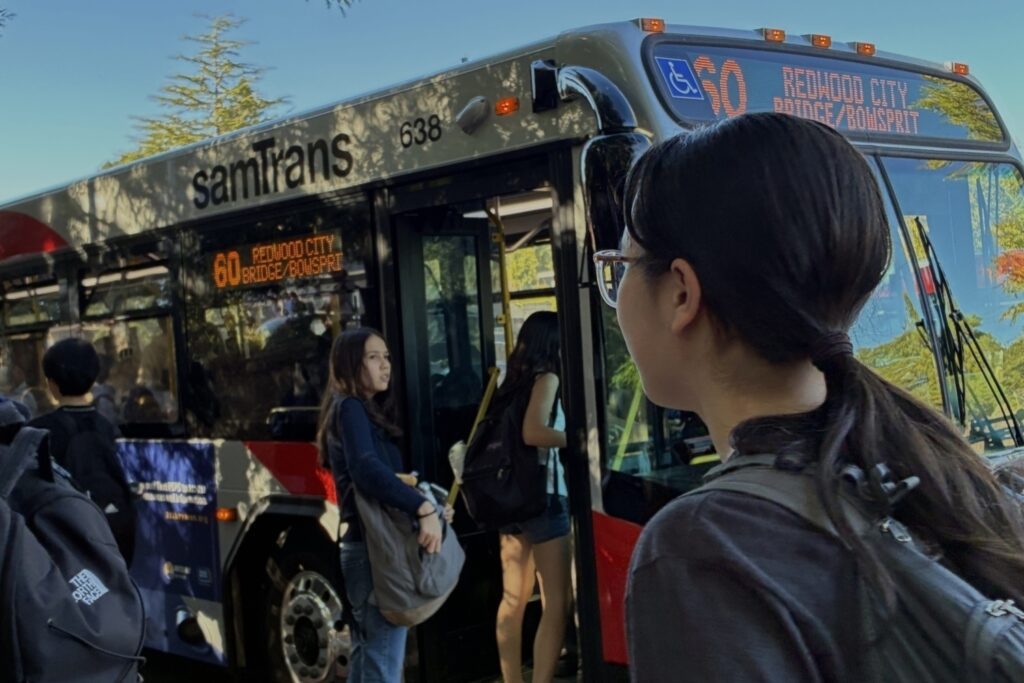Kathryn Ercoli, a sophomore at Carlmont High School, looks ahead as students board the San Mateo County Transit System 60 bus after school. The bus line begins to shrink a few minutes after the doors open. “I think the bus is pretty nice. It’s comfortable and there’s always a seat,” said Gul Surucu, a junior at Carlmont.
Public transportation is one of the most accessible ways for students to commute between school and home.
More than 10 million people have used the San Mateo County Transit System (SamTrans), the San Mateo County bus service, in 2025, which is nearly a million more than the year prior. Yet many more choose to drive. According to Axel Beaber, a freshman at Carlmont High School who takes the 60 and 62 SamTrans buses, the bus system has many caveats.
“The bus is not fun. It’s hard to get a seat, and people are loud. Sometimes I even see people vaping on the bus,” Beaber said.
In fact, weekday mornings have become notorious for their traffic, with cars packed together as students race to their first class. And many of the buses that Carlmont students take in the mornings are equally crowded, according to Lachlan Zhou, a freshman at Carlmont.
“Oftentimes, there is a lot of crowding while getting on the bus, and I get pushed around,” Zhou said.
Overcrowding is traditionally determined by the number of people per habitable place. Systems that rely upon this threshold are designed to ensure that long-term living conditions — including health, sanitation, privacy, and overall quality of life — are sustained.
However, public transit is designed to prioritize operational efficiency, comfort, and short-term safety. With these qualifications in mind, SamTrans is one of many public transit systems that have designed their buses to sustain 150% capacity, and are equipped with handlebars to acknowledge this exception, according to Ana Vasudeo, the San Mateo County Transit District Government and Community Affairs Manager.
“Legally, as long as people fit behind the yellow line around the driver’s seat, it’s fine,” Vasudeo said.
If a student or parent is concerned about overcrowding, they can call customer service to file a report.
“If customer service notices a pattern or multiple complaints, we will investigate the situation. This includes sending supervisors on buses to experience what the students do, and they will go multiple times to ensure that we did not happen to go on a day without classes or a time when an irregular amount of students are taking the bus,” Vasudeo said.
If SamTrans notices any issues, then they will consider assigning an extra bus or adapting a route. This is most commonly seen through location or time changes, which are part of a lengthy process.
Before the adjustment occurs, Lisa Chan, the San Mateo County Transit District Government and Community Affairs Specialist, will communicate with schools that frequently use that bus route through emails, flyers, and occasionally by putting ambassadors at commonly frequented bus stops to verbally announce the changes.
“I gave flyers to the Carlmont office earlier today to publicize the 61 bus route changes that will happen in November,” Chan said.
Beyond publicity, SamTrans must initiate changes in the driver’s schedule through their runbook, a document that details scheduling and service adjustments through quarterly updates. School administrators can report directly to the communications office, thereby increasing the likelihood that SamTrans will take their report seriously. However, one student decided to take action on the Carlmont campus.
Carlmont’s Transportation Club was founded in 2023 by Benjamin Mangiafico, a current junior.
“When I was younger, I learned about how cars are destroying the environment, and highways were designed to cut through low-income communities. I like transit and biking because not only is it fascinating for me, but it’s also advocating for making the world a better place,” Mangiafico said.
The club meets twice a month and educates students about local transportation systems. On Nov. 3, Chan spoke to the club as a representative from SamTrans about how to properly take the bus and passed out various flyers and prizes to increase students’ enthusiasm.
“Long term, I would like to get permanent signage about public transportation and how to access public transit around campus. A second facet would be to advocate to the cities of San Carlos and Belmont, primarily to get them to build better bicycle infrastructure,” Mangiafico said.

According to Jax Jewett, a sophomore at Carlmont who takes the 62 bus home every day, although the bus can become crowded, there are benefits.
“I think the SamTrans system is great. Sometimes the buses feel a bit crowded, but it’s manageable, and I always get a seat,” Jewett said.
Over the past few months, Mangiafico has attempted to publicize SamTrans through a number of signs posted in front of bus stops in San Carlos and Belmont.
“I got the idea from a friend of mine in San Diego who was putting up bus signs to help people navigate to the bus stop and tell them when the bus would come,” Mangiafico said.
SamTrans is similarly focused on fostering communication with students and encouraging them to take public transportation. Students who decide to take the bus have many payment options to choose from: cash, a Clipper card (either mobile or physical), a day pass, a Youth Unlimited Pass, or a credit card, beginning in December.
“I started the Transportation Club because I had the dream that there would be a few other people at Carlmont who would like transportation as much as me and I think that people should try to drive less because it is better for everyone,” Mangiafico said.


